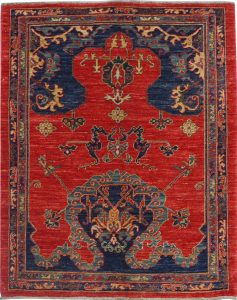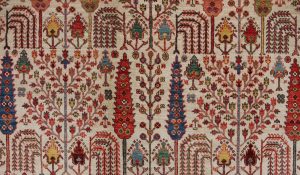Things you should know before buying a rug
About Persian Rugs
‘Persian rugs’ is a term for carpets woven by hand in what was, loosely, the
ancient Persian Empire; Turkey, The Russian Caucasus region, Iran,
Afghanistan, Pakistan, and India. In Europe, they are also known as
“Oriental Rugs”.
To be considered authentic, a Persian rug has to be hand woven, or hand-
knotted, and the entire weaving process carried out without the
assistance of a machine. A lot of time and skill is required to produce a
rug in the traditional way.
In choosing a carpet it is important to consult your own taste. You need to
find the carpet you are going to put in your house aesthetically pleasing.
While carpets are a good investment, their value as a capital gain accrues
slowly and unevenly. If you are happy with an asset that will keep pace
with inflation, and, with reasonable care and maintenance, not depreciate,
then you will be well served, financially.
There is currently a ‘buyer’s market’ for Persian carpets, caused by the
embargo of Iran by the United States. The closure of this, the world’s
largest consumer market (formerly taking over 65% of the available Persian
rugs in any given year) makes for enormous pressure and competition for
dealers, on the markets in other countries (such as Australia).
However, It is also noticeable that the supply of high-grade examples is
drying up. Many makers of carpets are sole traders and family businesses,
and there are more profitable ways for them to expend their energy. Also,
because every rug is different it is difficult to market a commodity where
the product has no standard parameters, even for something as basic as
size.

There are well over 2,000 different, recognizable types of Persian rugs but
within all those types there are only three major categories and they are as
follows.
a) Urban weaves:
These are the types from the major centers. They are woven by
professional weavers, the materials used include wool, silk, and cotton. The
designs are (usually) of curvilinear form, the weave is fine (closely
compacted) and the pile is short and velvety.
b) Village & Nomadic weaves:
As the name implies, woven in the smaller villages or in a tent as a cottage
industry. The weavers are not professional, the fabric is coarser and more
‘countrified’. Material composition is usually wool pile on cotton or wool
foundation, designs are usually angular (geometric).
As with many textile arts and crafts, women are well-represented in the
world of carpet production. Weavers are almost always women, and the
rug-weaving knowledge is held by women and passed on from mother to
daughter. Wool dyers are mostly male. Village and tribal rugs are woven
into traditional designs that are specific to a region, clan, or even a family
group. Sometimes a pattern, called a “varigeh”, is used, but often the
design is recalled from the memory of the weaver.
An urban weaver can only start the project after a design has been
created. They need to know the colour of the wool (or silk) that must be
used for each individual knot. So, first, a design is conceived by a designer
and is plotted in colour on graph paper, with one square on the paper
equal to one knot on the rug. This serves as the weaver’s guide. Fine Urban
rugs are woven under the supervision of a master weaver. When
comparing rugs remember you can only compare rugs of the same type.
There is probably no handmade rug with a perfectly balanced symmetrical
design. Every handmade rug is unique in its own way, which is one of the
reasons why rugs are so fascinating and enduringly popular.

If you’re going to spend money on a Persian rug you’ll obviously want an
item that, if cared for, retain its beauty and value. Longevity depends a lot
on the purpose for which you will use the rug. If it is to go under a dining
room table, it is wise to select a type that is woven on a cotton foundation,
as an all-wool rug could possibly stretch in that particular type of use.
However, an all-woollen rug is wonderful on an uneven floor such as stone
or slate, or quarry tiles. If the area that is to take the rug is heavily
trafficked, such as an entry foyer, then a solid durable weave is best. Silk
rugs are best placed in light traffic areas, or hung on a wall. Antique rugs
should be gently treated.
